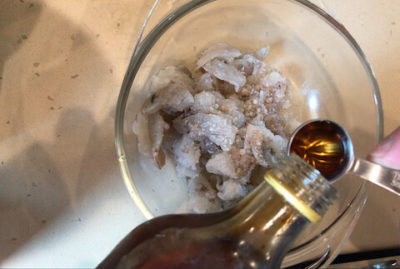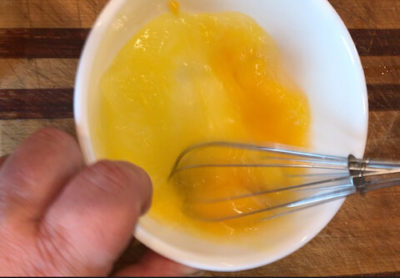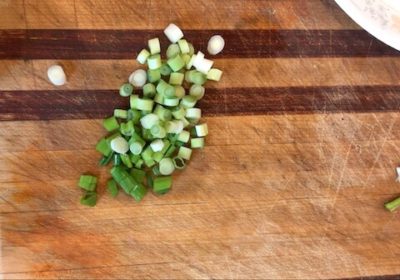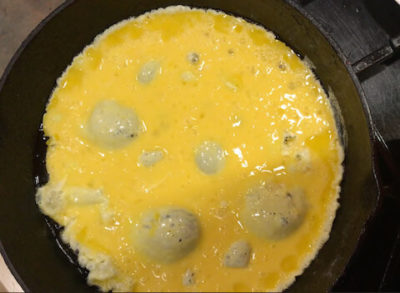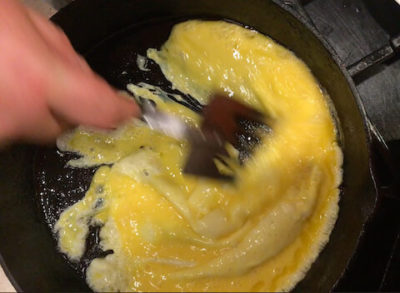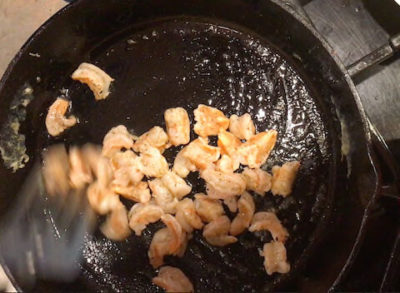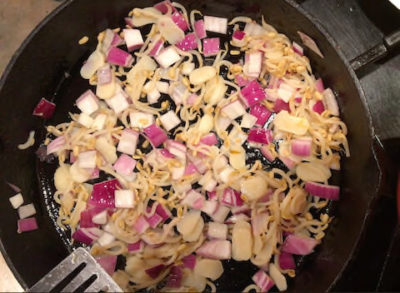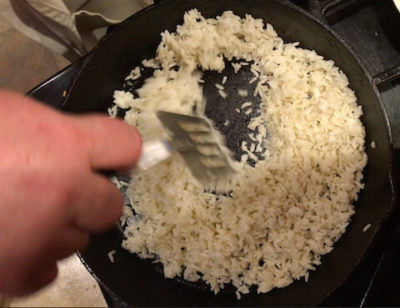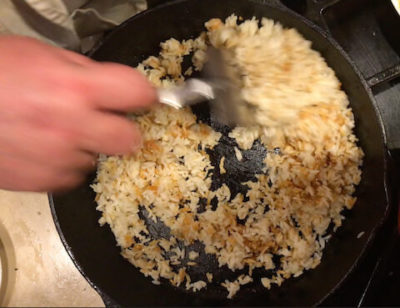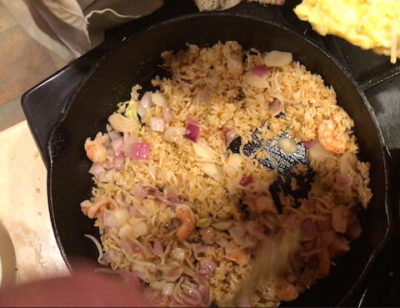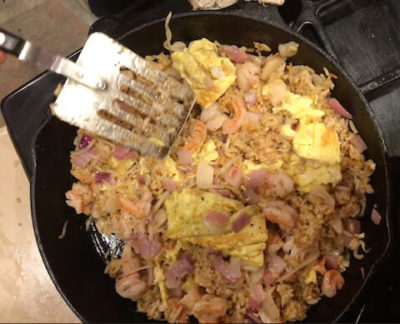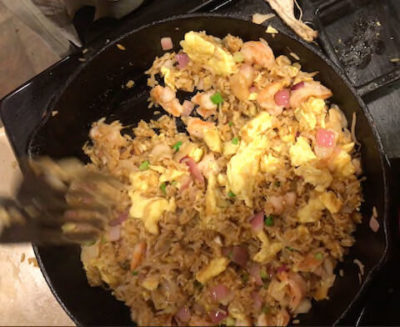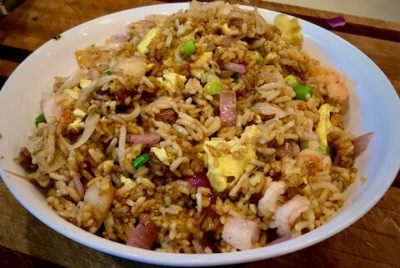Fried rice is a snack food in China. According to the late Irene Kuo, it is not usually served with a meal, as its mix of ingredients would and seasonings would detract from the main dish. Fried rice is mainly a way to reheat and use up leftover rice. The Cantonese do not season their fried rice with soy sauce. Northern chefs do tend to use soy sauce. The ingredients for fried rice vary with geography and local agriculture, just like the eight cuisines of China. Shrimp Fried Rice is a popular variety.
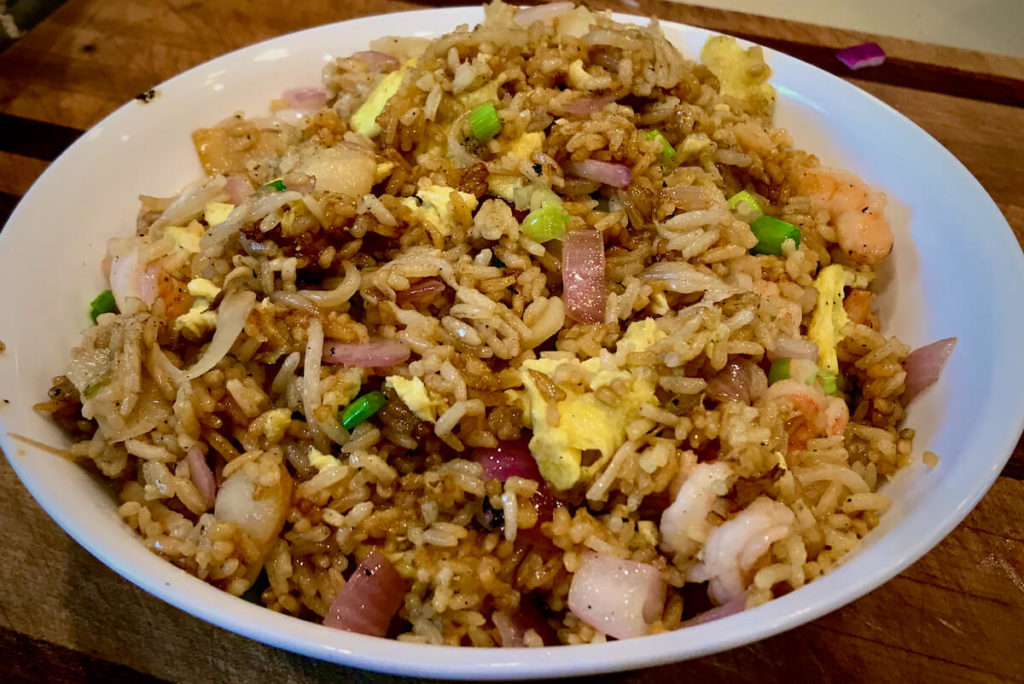
This Shrimp Fried Rice recipe is my own. I use Irene Kuo’s technique with the eggs, described below. However, for the fried rice recipe, I add or substitute ingredients that Kuo does not list in her shrimp fried rice recipe, based on personal preference. There are many recipes for shrimp fried rice, and each one is personal to the chef or home cook who created the recipe. For example, home cook CC, of Asian Cooking Mom, who was born in Beijing and now lives nearby in Austin, Texas, uses peas in her shrimp fried rice.
Kuo recommends a coating for the shrimp, with salt, and one part cornstarch to two parts water. I do not care for this. Instead, I marinate the shrimp with a bit of salt and Shaoxing wine.
Home-cooked fried rice
While we at My Chinese Home Kitchen try to remain true to authentic Chinese home recipes, the fact of the matter is that with fried rice, there is no single authentic way to prepare the dish. The goal is to make an interesting snack from leftover rice. This makes fried rice a good medium for experimenting and learning. Chinese cuisine is about contrasts. The contrast of flavors, and the contrast of textures, as well as the contrast of nutrients and the contrast of warming and cooling foods. So, you can experiment contrasting ingredients, such as bean sprouts, bamboo shoots, and red onion which have a slightly crunchy and juicy texture, with ingredients like meat or shrimp which have a more chewy texture, and ingredients like eggs, peas, or leafy greens, which have a soft texture.
Tips for making shrimp fried rice
The secrets to a good fried rice are simple:
- start with cold, day old or older, firm rice: If the rice is sticky or mushy, it will become a sticky, mushy fried rice
- use very little oil: you need enough to keep it from sticking to the pan, but a well-seasoned pan reduces the need for oil; add more oil sparingly and only if the rice is sticking to the pan
- remember the goal is to reheat the rice, not fry it to a crisp
- your finished dish should be light and fluffy and tender, not sodden with grease or mushy
You do not need a wok and a professional stove to make fried rice
If you read a lot of professional cookbooks, you’ll see how the restaurant wok is used, or the traditional wok on a hearth stove. These stoves are volcanoes. Your kitchen stove won’t get this hot. If you use a cast-iron skillet like I do, it will never have the heating and cooling profile of a good wok on a professional 150,000 BTU commercial stove with high-pressure gas. The good news is the typical Chinese home does not have these things either. If you start with firm, cold rice, and you take the time to let your skillet or wok get hot between ingredients, you can make a delicious, homemade shrimp fried rice.
Making fluffy eggs
For light, fluffy scrambled eggs, you can use this technique for a breakfast or for fried rice. I use a cast-iron skillet, but you can do this in a wok too. Get the wok or pan hot. Add enough oil to cover the bottom, but do not drown the skillet in oil. Beat the eggs in a bowl with a whisk until thoroughly mixed. Pour the eggs into the wok or skillet.
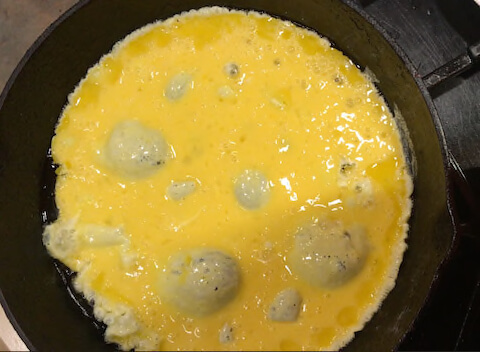
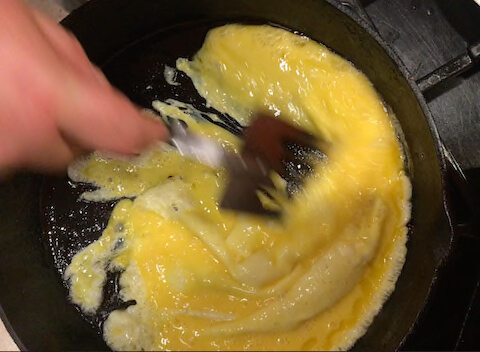
When the eggs begin to firm up and fluff around the edges, use your spatula to push them to the far side of the pan or wok. Then tilt the pan so that the runny portion of the eggs flows back onto the hot cooking surface of the pan.
Once all the liquid portions of the egg are firm, use your spatula to quickly flip the mass of eggs and finish. Use your nose as a guide. You can tell by the aroma when the eggs are firm, and if they begin to brown on the bottom you will smell this too. Do not let them get browned and dried. Flip them, let them firm up, and remove to a plate for use in the final stage of the cooking.
Shrimp Fried Rice
Equipment
- 1 wok or cast iron skillet with deep sides
- 1 plate
- 2 bowls
Ingredients
- 3 cups cooked white rice
- ½ pound raw shrimp (medium or large)
Accessory ingredients
- 3 scallions
- ¼ cup bean sprouts
- 8 water chestnuts (optional)
- 4 eggs
- ½ red onion, small
- caiziyou (roasted rapeseed oil) (substitute canola oil, peanut oil, or sobyean oil)
Seasoning
- 1-2 tsps light soy sauce
- 1 tsp Shaoxing wine
- ½ tsp salt
Instructions
Preparation
- Rinse the shrimp. Then peel and de-vein the shrimp. For larger shrimp, cut them cross-wise into two pieces. Place the pieces in a bowl.
- Add the Shaoxing wine and salt to the shrimp, stir to combine, and set aside.
- Break the eggs into a bowl and beat rapidly.
- Chop the scallions and set aside.
- Dice the red onion and slice the water chestnuts.
Cooking
- Heat the wok or frying pan on high flame. When hot, add 2 tablespoons of oil, swirl to coat the pan, and pour the eggs into the pan.
- As the eggs begin to firm up and bubble, push them to the far side of the pan, or wok, and tilt the pan so that the liquid part of the egg runs off the egg and onto the hot pan. This makes the eggs light and fluffy. Turn the eggs once to finish and pour from the pan to a plate.
- Heat the wok or pan. When hot, add 1 tablespoon of oil, swirl to coat the pan, and add the shrimp. Stir-fry the shrimp until pink and firm, but do not overcook. Transfer the shrimp to the plate with the eggs and clean the wok.
- Heat the wok on high heat. When hot, add 1 tbsp of oil, and stir-fry the water chestnuts, red onion, and bean sprouts rapidly until heated and tender. Transfer the vegetables to the plate with the eggs and shrimp.
- Heat the wok or pan on high heat to very hot. When hot, add 1 tbsp of oil, swirl to coat the pan, and add the rice. Stir and poke the rice rapidly, turning to ensure even heating.
- When the rice begins to pop, add 1 tsp of light soy sauce around the edge of the pan. Stir fry rapidly to combine. If the rice begins to stick, add a little more oil to the pan. Do not drown the rice in oil. use only enough to keep it from sticking.
- Check for taste. If desired, add another tsp of light soy sauce and mix rapidly.
- Add the ingredients from the plate to the rice, and stir-fry rapidly to mix and combine.
- Add the eggs and shrimp and stir-fry for a few seconds to combine.
- Finally, add the scallions, stir fry for a few moments to combine and remove from the heat.
- Transfer to a serving bowl and serve.
Notes
- Red onion, water chestnuts, and bean sprouts are optional. They add nutrition, texture, and flavor, but are not required.
- You can substitute other vegetables, or just cook the rice with the egg and shrimp if you prefer. Some people prefer green peas in their fried rice.
- Use a quality light soy sauce. I recommend Zhongba, but Lee Kum Kee is also good. Cantonese-style fried rice does not use any soy sauce during the cooking. So this is optional.
- Light soy sauce is not the same as “low-sodium” soy sauce. Read our article about how soy sauce is made to understand the difference between light and dark soy sauce.
- By letting the eggs firm and bubble in the hot pan and pushing to one side and tilting to run the liquid egg into the pan, the eggs will be very fluffy. If you handle them too much with the spatula, the eggs will be tougher and firm, not fluffy.
- Chef Irene Kuo, in her classic work The Keys to Chinese Cooking, recommends mixing the shrimp with a coating of 1/4 tsp salt, and a mix of 1 teaspoon (5 ml) cornstarch and 2 teaspoons (10 ml) water. This will give the fried shrimp a slightly crunchy texture. I prefer the texture and taste of the shrimp marinated in Shaoxing wine and salt.
Cooking rice for fried rice
For best results, you want a dry, cold, firm rice grain, not a sticky, clumpy, mushy grain when you stir fry. Warm, fresh cooked rice is too moist and soft for a good stir-fry. Remember, this is a way to use leftover rice. When making white rice, use long grain rice and less water than called for on the cooking instructions on the bag.Grace Young’s “Classic” Rice
After trying several methods of preparing rice in a saucepan, I have found that the best results come from Grace Young’s technique. Young recommends rinsing the rice with cold water several times, until the water runs clear. This washes away extra starch. Starchy rice will be gummy, or sticky. Then she levels the rice in a 1.5 quart saucepan and covers the rice with 1 inch of water. (For 1 1/3 cup rice in a 1.5 quart saucepan, this is about 1 2/3 cup water.)- Bring the water to a boil, reduce heat to medium, and simmer uncovered until craters form in the rice.
- Then cover the saucepan, reduce the heat to low, and simmer for 10 minutes or until all water is absorbed.
- Immediately fluff the rice with a fork.
(Young, Grace. Stir-Frying to the Sky’s Edge: The Ultimate Guide to Mastery, with Authentic Recipes and Stories. Simon & Schuster.)Let the rice cool, but not longer than two hours at room temperature. The moist rice will begin to ferment, especially on warm humid days. When the rice is cool to room temperature, refrigerate overnight, or up to 3 days.
Nutrition
Do you enjoy My Chinese Home Kitchen?
We enjoy sharing these authentic home recipes with you. Learn more about My Chinese Home Kitchen at our About page.
Please leave a comment, or SUBSCRIBE to our newsletter.
For more of our original videos, visit My Chinese Home Kitchen on YouTube and Rumble.



